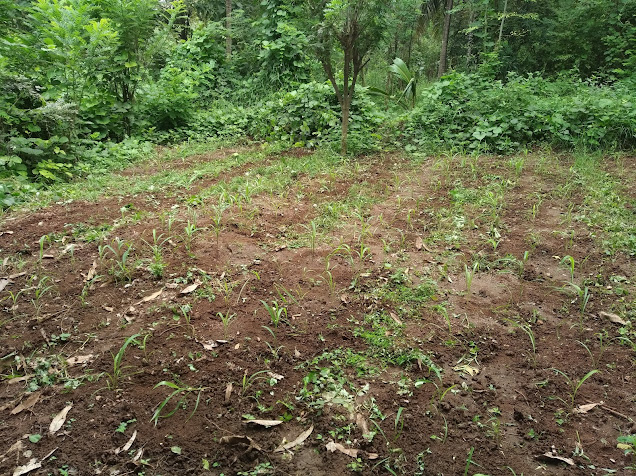No till surface seeding of millet was not giving good results so thought of trying minimum tillage experiments. A small patch was cut using Scythe and small grasses further cut using Honda brush cutter. Long grasses are easily cut using Scythe and then for close cutting Brush cutter was used. May be a better choice will be flail mower which grinds the weeds into fine powder, have seen tools like BCS with fail mower attachments, right now it is not affordable. BCS walk behind tractor also has power harrow attachment which tills soil to a minimum height, this is another option which can be tried. There is also Precision Depth Roller which also has to be explored further.
A small 2 feet area was marked (length wise) with locally made Folkin's hoe. This area is further cleaned using hoe and then channels are made using sharp edge of Fokin's hoe and seeds were put at around 10cm gap. At each place around 2-3 seeds were put and then covered it with Fokin's hoe.
Sorghum,foxtail millet and finger millet seeds were put.
Tomy sometime helps me!
03-Sept-2020
To my surprise the land became very dry and none of the seeds germinated. While millets I planted during the rainy season had germinated well, moisture is the most critical aspect. On August 31st we got a good rain, so again wanted to try millets. But because of the festival could go to the farm only after 3 days, by the time, it was relatively dry, still wanted to give a try. Cut the grass using scythe, then marked line using Fokin's hoe and then cleared the grass using hoe and then marked rows using Fokin's hoe and then put seeds at around 0.75feet. This was relatively easy task, may be if we have brush cutter with plastic thread, the whole thing can be made much faster. The idea of making rows and then putting seeds at a regular distance is to make the weeding easier. I feel if we do 2 or 3 weeding using Fokin's hoe, then crop can establish quite well.
I had to cut few branches of the nearby mango tree, this along with cut grass was piled up for decomposition, mulching the whole area with grass seems like troubling the germination, so planning to compost and put it back to this area.
Area before cutting, one portion was planted earlier which failed..
Piled up grass and mango leaves..
Field after planting..Mulching with newly cut grass is bit tricky...may be next time, the mulch left for decomposition can be spread back
08-September-2020
Could see only a few plants of foxtail millet...germination rate is bad, may be because of less moisture. At the time of sowing, ground was wet, but after that no rains and it was bright hot sun. Also who knows, ants also might have pickup some. One option is to put really more seeds, may be 8-10 seeds, so that at least one will come up in that place.
23-October-2020
Finally transplanted some seedlings and weeded them once using Fokin's hoe











